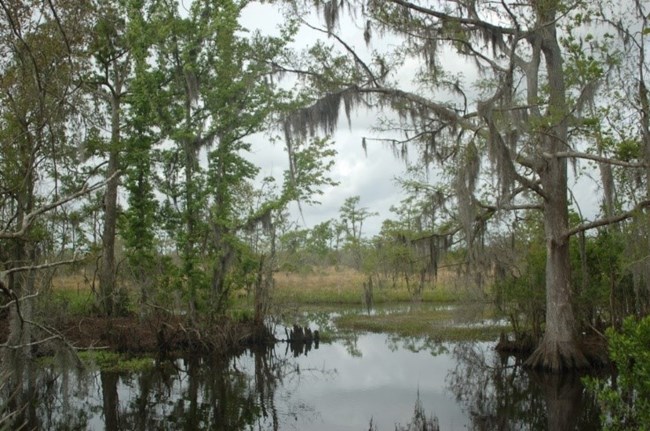Last updated: September 25, 2018
Article
Barataria Preserve Trail-Based Water Quality Monitoring Project
Citizen science is when members of the public participate in the scientific process through collaboration with scientists and organizations. This is one case study demonstrating the value of citizen science in helping the National Park Service to meet its mission.
Case Study Overview
The Barataria Preserve in Jean Lafitte National Historical Park and Preserve (JELA) is the park's wildest site with more than 23,000 acres of swamp, marsh, trails, and waterways, a living laboratory of Louisiana's endangered wetlands. The Barataria Preserve elevation and hydrology dynamics monitoring array project was a citizen science collaboration between JELA ecologists, staff, and college interns. It sought to develop an understanding of basic water quality conditions at the park and assess interior freshwater wetland locations not already studied by regional NPS Inventory and Monitoring teams.

Project Description
Interns used YSI Pro series and Hach monitoring instruments to make various water quality observations at 20 specific locations around the Preserve accessible via public trails. They recorded factors such as temperature, pH, conductance, salinity, and dissolved oxygen. Field observations were recorded using an electronic form on a field-portable tablet. Interns and park staff ensured collected data were appropriately transferred to cloud-located database.
In addition, participants received training in how to prepare, clean, and calibrate instruments following a standard protocol. Between 2013 and 2015, interns also performed quality control checks on field-transcribed data and undertook exploratory data analysis. The collected data can be used in JELA’s Action Plan and Hurricane Action plan implementation, and addresses environmental conditions monitoring objectives.
Challenges
One challenge to the monitoring was having enough people to conduct the work. Field work is most efficiently and effectively accomplished by a two-person team. Park staff benefitted from the support provided by interns.
Benefits and Outcomes
This project contributed to the conditions monitoring component of JELA/JAZZ Climate Friendly Parks Action Plan by developing a baseline dataset against which anticipated water quality changes may be compared. More broadly, the collected data can easily be compared to aquatic habitats similar to those sampled in this program.
The project contributed to the park’s wider effort of involving youth in park programs, as well as potentially recruiting more scientific investigator partners by producing relevant environmental datasets.
Tips
The Barataria Water Quality Project case study illustrates the following steps in the Federal Citizen Science and Crowdsourcing Toolkit:
- Scope Your Problem—Know Your Tools: This project assessed areas not included in previous water quality studies.
- Scope Your Problem—Engage Your Stakeholders and Participants: College interns provided park staff with needed assistance, and were able to receive training in scientific procedures.
- Manage Your Data—Acquire Your Data: Interns and park staff followed standardized procedures in the field.
Contact
Julie Whitbeck, Ecologist Email: Julie_whitbeck@nps.gov
